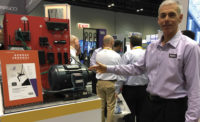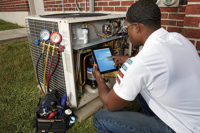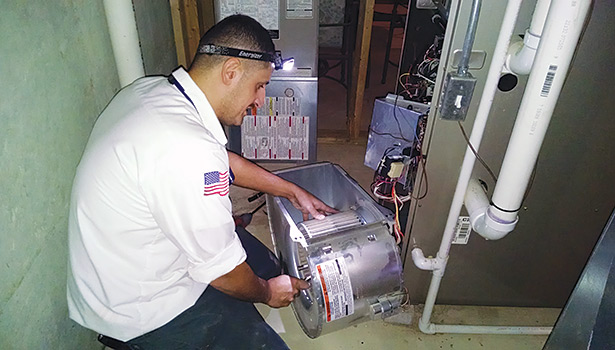Retrofitting PSC Motors with ECMs
Replacing PSC Motors with ECMs Can Boost Bottom Line, Improve Customer Comfort

When a customer’s old blower motor fails, some contractors use that opportunity to sell them a more efficient blower motor instead of replacing it with another single-speed motor. (Photo courtesy of Yusef Zindani/Thornton & Grooms)

A technician from Thornton & Grooms, Farmington Hills, Michigan, services a customer’s blower motor. (Photo courtesy of Yusef Zindani/Thornton & Grooms)

Several manufacturers have designed variable-speed blower motors specifically as retrofit replacements for less efficient single-speed blower motors. (Photo courtesy of Yusef Zindani/Thornton & Grooms)



HVACR technicians have traditionally swapped out customers’ faulty blower motors with like motors, and, more often than not, those motors have been single-speed permanent split capacitor (PSC) units.
But, over the years, several manufacturers have developed variable-speed electronically commutated motors (ECMs) specifically designed as retrofit replacements for faulty PSC motors. And, while not all contractors consistently offer ECMs, those who do often report increased profits as well as improved customer comfort and satisfaction.
When and Why
Dave Knight, co-owner and director of sales and marketing at Thornton & Grooms in Farmington Hills, Michigan, said the company most often uses a multimeter to diagnose a failed motor, though it is also common for customers to complain about a screeching sound or burning smell coming from the furnace. Motors are also sometimes damaged after being exposed to water.
“We replace a PSC with an ECM about 25 percent of the time,” Knight said. “We are seeing this percentage increase as customers become more aware of ECM motors.”
Travis Smith, owner of Sky Heating & Cooling, Portland, Oregon, said there are several benefits to replacing a failed PSC motor with a variable-speed motor.
“The ECM fans are liked by a lot of people because they are quieter and they do a better job circulating the air,” he said. “We used to use the Evergreen ECM blower motor as a replacement for PSC motors but have switched to the MARS Azure™ Digi-Motor®. I would say about 30 percent of customers who have a bad PSC blower motor are upgrading to the ECM fans.”
“We use the Legacy PSC motor and the Genteq Evergreen ECM motor,” Knight said. “Most PSC motors are very similar in design, performance, and warranty, so we use Legacy, as it is most available from our supplier. Our techs like the Evergreen because it offers easier installation, and its setup features and options allow us to adapt to the various applications we encounter.”
Steve Moon, owner of Moon Air Inc. in Elkton, Maryland, said clients rarely replace a motor before it fails. “About 10 percent of the time, [ECMs] are offered, but we find many clients are resistant due to budget constraints,” he said. “We work hard to get the smart ones to replace when we see them pulling high amps at the time of the tuneup.”
John Steinert, service manager, Meyer & Depew Co., Kenilworth, New Jersey, said all of the company’s technicians “would rather be installing and working on ECM motors” because they’re quieter and provide more options and control over airflow. “The proper airflow is important because, without it, you’ll not be getting the efficiency the equipment was rated for.”
Potential Setbacks
Though ECMs are designed to save energy and improve customer comfort, dropping one into a system that is already dysfunctional will only ensure the motor does not meet its full energy-savings potential. “Many older homes and track homes have multiple bends and/or undersized ductwork, causing extreme static pressure,” said Sam Krumholz, CEO at Bentwood Consulting, Gaston, Oregon. “Either of these would make installation of anyone’s ECM a waste of money without considerable system rework.”
“Give the customer true value by repairing the duct airflow design problems,” said Billy Mozingo, HVAC department chair at Pitt Community College, Greenville, North Carolina. “It is a fact that if the duct system is truly as bad as it’s been mentioned here, the ECM will use even more power than the PSC.”
Steinert agreed, saying, “The proper airflow is important because, without it, you will not be getting the efficiency your equipment was rated for.”
Dave Dombrowski, manager, ARS/Rescue Rooter, Raleigh, North Carolina, said the payback in energy savings in North Carolina doesn’t justify the cost of upgrading to a variable-speed motor.
“ARS of Raleigh does not typically replace a PSC motor with anything but a like replacement,” he said. “We are major believers in ECM motors. We recommend them as part of a system replacement. The newer air handlers and furnaces that have these motors also incorporate significant design changes that add to their value in saving energy. To upgrade just this one item does not seem to be in the best interest of the customer, in our opinion.”
A variable-speed motor will not be nearly as effective if the ductwork is not up to par, said Dombrowski. “Because of the nature of these motors, they will adjust to provide the proper airflow to the system. If the duct is not properly sized and sealed, this make-up air will come from the small openings in the duct fittings,” he said. “Our approach emphasizes the need to look at the entire system and the thermal envelope and make recommendations based on what is best for the homeowner.”
How to Sell ECMs
Many contractors believe consumer education is the best way to upsell to an ECM, and taking the time to explain the technology and its benefits is often all that is needed to make a sale.
“We tell our clients about the benefits of ECMs,” Steinert said. “[We say] they’re more efficient to run, are much quieter, and can help control a system’s airflow.”
Moon said he uses a tablet in the field so technicians can “simply show a YouTube video” about the benefits of ECMs.
But, when talking to customers, technicians should be conscious of the amount of detailed technical information they provide. For many customers, it can be overwhelming.
“Rather than explain the technology behind the solutions, we explain the benefits the solutions offer and how they address the customers’ issues,” Knight said. “We find that most people aren’t concerned with how things work, but what the things we offer can do for them. … We also use analogies, symbols, and make simple drawings to help communicate the advantages with the customer.”
Additionally, if rebates are available for homeowners through utility companies or some other entity, contractors can take advantage of that to upsell to an ECM. “Many states offer energy rebates for installation of these motors, which help contractors up-sell these motors as replacements for PSC motors,” Krumholz said.
Knight said the best thing contractors can do is listen to customers. “Through observations and conversations, we typically find the customer is having more issues than the effects of a failed motor — things like high energy bills, poor temperature control, uneven temperatures, inconsistent humidity control, allergy symptoms, and excessive dust,” Knight said. “So, we provide the customer a short list of options that solve these issues in the form of bundled solutions, and many of these solutions can be enhanced with a dollar-saving air circulator.”
Publication date: 12/8/2014
Want more HVAC industry news and information? Join The NEWS on Facebook, Twitter, and LinkedIn today!










